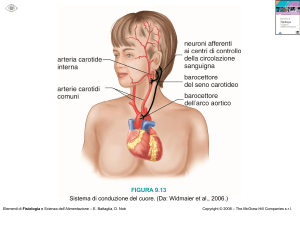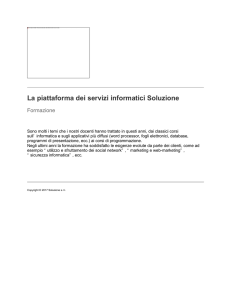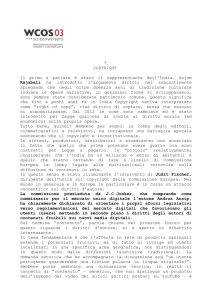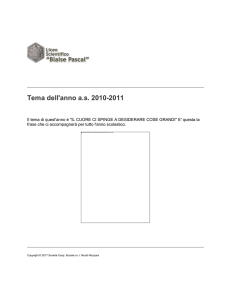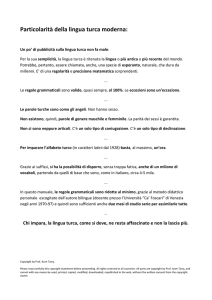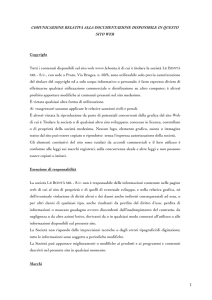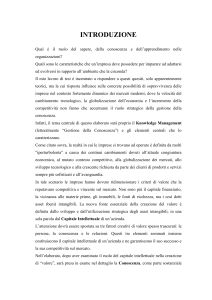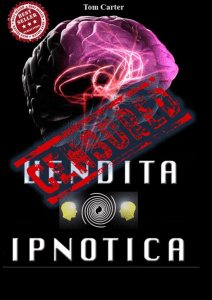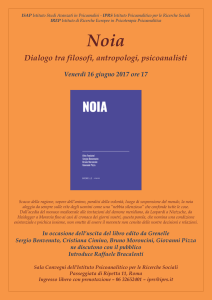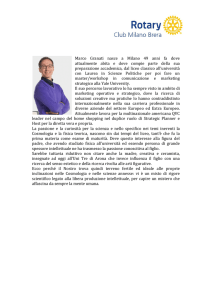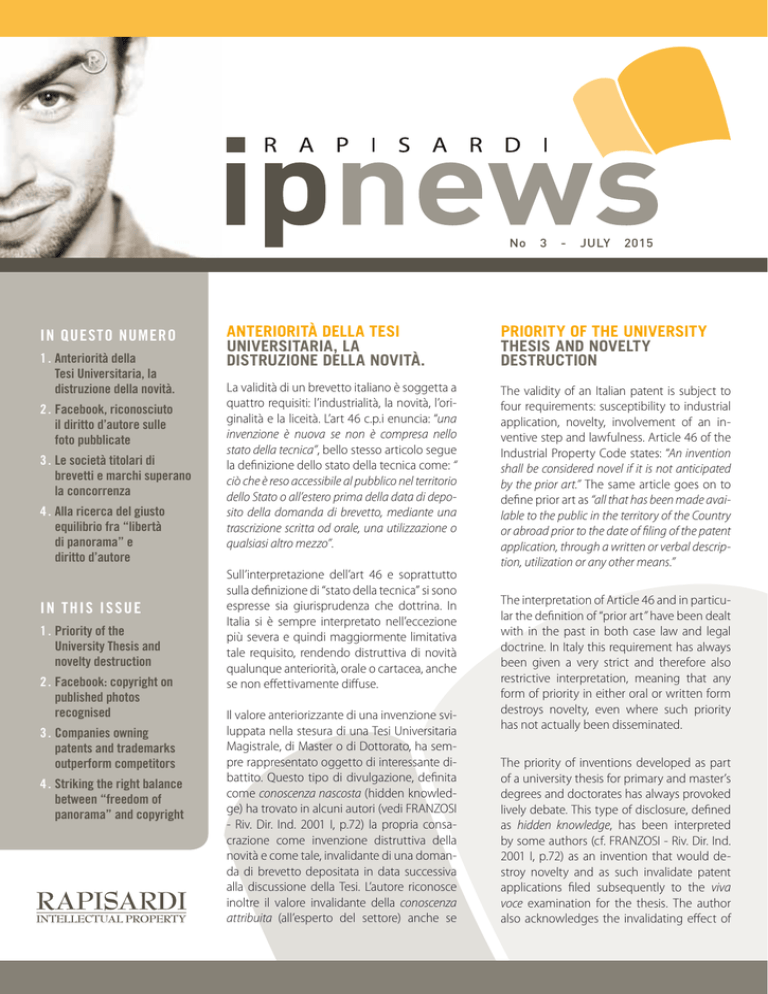
No
IN QUESTO NUMERO
1 . Anteriorità della
Tesi Universitaria, la
distruzione della novità.
2 . Facebook, riconosciuto
il diritto d’autore sulle
foto pubblicate
3 . Le società titolari di
brevetti e marchi superano
la concorrenza
4 . Alla ricerca del giusto
equilibrio fra “libertà
di panorama” e
diritto d’autore
IN THIS ISSUE
1 . Priority of the
University Thesis and
novelty destruction
2 . Facebook: copyright on
published photos
recognised
3 . Companies owning
patents and trademarks
outperform competitors
4 . Striking the right balance
between “freedom of
panorama” and copyright
3
-
JULY
2015
ANTERIORITÀ DELLA TESI
UNIVERSITARIA, LA
DISTRUZIONE DELLA NOVITÀ.
PRIORITY OF THE UNIVERSITY
THESIS AND NOVELTY
DESTRUCTION
La validità di un brevetto italiano è soggetta a
quattro requisiti: l’industrialità, la novità, l’originalità e la liceità. L’art 46 c.p.i enuncia: “una
invenzione è nuova se non è compresa nello
stato della tecnica”, bello stesso articolo segue
la definizione dello stato della tecnica come: “
ciò che è reso accessibile al pubblico nel territorio
dello Stato o all’estero prima della data di deposito della domanda di brevetto, mediante una
trascrizione scritta od orale, una utilizzazione o
qualsiasi altro mezzo”.
The validity of an Italian patent is subject to
four requirements: susceptibility to industrial
application, novelty, involvement of an inventive step and lawfulness. Article 46 of the
Industrial Property Code states: “An invention
shall be considered novel if it is not anticipated
by the prior art.” The same article goes on to
define prior art as “all that has been made available to the public in the territory of the Country
or abroad prior to the date of filing of the patent
application, through a written or verbal description, utilization or any other means.”
Sull’interpretazione dell’art 46 e soprattutto
sulla definizione di “stato della tecnica” si sono
espresse sia giurisprudenza che dottrina. In
Italia si è sempre interpretato nell’eccezione
più severa e quindi maggiormente limitativa
tale requisito, rendendo distruttiva di novità
qualunque anteriorità, orale o cartacea, anche
se non effettivamente diffuse.
Il valore anteriorizzante di una invenzione sviluppata nella stesura di una Tesi Universitaria
Magistrale, di Master o di Dottorato, ha sempre rappresentato oggetto di interessante dibattito. Questo tipo di divulgazione, definita
come conoscenza nascosta (hidden knowledge) ha trovato in alcuni autori (vedi FRANZOSI
- Riv. Dir. Ind. 2001 I, p.72) la propria consacrazione come invenzione distruttiva della
novità e come tale, invalidante di una domanda di brevetto depositata in data successiva
alla discussione della Tesi. L’autore riconosce
inoltre il valore invalidante della conoscenza
attribuita (all’esperto del settore) anche se
The interpretation of Article 46 and in particular the definition of “prior art” have been dealt
with in the past in both case law and legal
doctrine. In Italy this requirement has always
been given a very strict and therefore also
restrictive interpretation, meaning that any
form of priority in either oral or written form
destroys novelty, even where such priority
has not actually been disseminated.
The priority of inventions developed as part
of a university thesis for primary and master’s
degrees and doctorates has always provoked
lively debate. This type of disclosure, defined
as hidden knowledge, has been interpreted
by some authors (cf. FRANZOSI - Riv. Dir. Ind.
2001 I, p.72) as an invention that would destroy novelty and as such invalidate patent
applications filed subsequently to the viva
voce examination for the thesis. The author
also acknowledges the invalidating effect of
questa sia di reperibilità estremamente difficile, portando ad
esempio proprio una tesi di Laurea in una Università benché
lontana, poco conosciuta e non famosa per la materia oggetto dell’invenzione.
the constructive knowledge (of a person skilled in the art), even
where it is very difficult to access such knowledge, indeed
providing the example of a graduation thesis in a distant and
little-known University with no reputation for specialisation in
the subject matter of the invention.
Questa interpretazione dottrinale ha goduto di un forte seguito anche nella giurisprudenza nazionale che più volte,
(per tutte trib. Bologna n.r.g. 8552/2012) ha definito come
pacifico il riferimento alle tesi di laura nell’elencazione delle
anteriorità documentali.
This doctrinal approach has been widely adopted, not least in
Italian case law, which has on several occasions, (see Court of
Bologna Reg. No 8552/2012) allowed graduation theses to be
listed among prior art documents.
Contrariamente alla giurisprudenza ed al diritto italiano,
l’Ufficio Europeo Brevetti ha messo in discussione la natura
invalidante una Tesi Universitaria in quanto tale, richiedendo
invece una verifica delle modalità che hanno caratterizzato
la “disclosure” delle informazioni e quindi una verifica delle
modalità di esposizione della Tesi in sede di discussione.
The European Patent Office, however, unlike Italian law and
legal precedent, has questioned the invalidating capacity of
university theses per se, requiring verification of the manner
in which disclosure of information took place and therefore
also of the manner in which the thesis was expounded when
discussed.
Nella motivazione della decisione del 25 ottobre 2010 del
caso n1057/09, la Corte d’Appello dell’Ufficio Europeo Brevetti
ha ritenuto non invalidate una Tesi Universitaria, per quanto
questa fosse nuova, poiché non ha riscontrato oltre ogni ragionevole dubbio che, durante il colloquio di discussione della Tesi in sede di Laurea, l’invenzione oggetto della Tesi fosse
stata esplicitamente svelata dal laureando.
In the reasons for the decision handed down on 25 October
2010 in case No 1057/09, the Boards of Appeal of the European
Patent Office stated that a specific university thesis did not
have an invalidating effect, regardless of whether it was novel,
since the Board was not convinced beyond any reasonable
doubt that the invention that was the subject matter of the
thesis was clearly and unambiguously disclosed by the candidate during the oral presentation for the thesis.
Con questa decisione, la Corte d’Appello dell’Ufficio
Europeo Brevetti, ha interpretato l’articolo 54 comma 2 della
Convenzione sul Brevetto Europeo prescindendo da qualsivoglia presunzione sulla natura delle conoscenze nascoste, entrando così nel merito delle modalità che hanno caratterizzato l’esposizione della Tesi Universitaria che, nel caso specifico,
si è svolta appositamente nel rispetto del segreto di tutte
quelle informazioni che se divulgate avrebbero certamente
comportato una perdita di novità del successivo brevetto.
In its decision, the Boards of Appeal of the European Patent
Office interpreted Article 54 (2) of the European Patent
Convention without entering into the question of the nature
of hidden knowledge, instead concentrating on the manner in
which the university thesis was presented: in this specific case
a secrecy undertaking covered the subject matter, which if
disclosed would certainly have destroyed the novelty of the
subsequent patent.
La decisione di cui sopra, benché inerente al Brevetto
Europeo, si sposa con il principio italiano secondo il quale:
“non si abbia perdita di novità quando l’invenzione viene comunicata a terzi sotto vincolo di segreto”(VANZETTI, DI CATALDO
- Manuale di diritto Industriale ed. 2012 §23). Offrendo così, a
seguito di una oculata scelta degli argomenti da esporre, ai
ricercatori che sviluppano un’invenzione nella stesura della
propria Tesi di Laurea uno strumento per mantenere segreta
l’invenzione e poterla sfruttare economicamente anche in un
tempo successivo alla sua esposizione.
Giacomo Garbagnati
Junior attorney
This decision, albeit involving a European Patent, is in line
with the Italian principle that states: “there is no loss of novelty
when the invention is communicated to third parties bound by a
nondisclosure undertaking” (VANZETTI, DI CATALDO - Manuale
di diritto Industriale, Ed. 2012 §23). This offers researchers developing an invention while drafting their graduation thesis,
following careful selection of information to be presented, an
instrument for maintaining the secrecy of the invention and
allowing its economic exploitation even following this type
of disclosure.
Giacomo Garbagnati
Junior attorney
3
No 3 - JULY 2015
FACEBOOK, RICONOSCIUTO IL DIRITTO
D’AUTORE SULLE FOTO PUBBLICATE
FACEBOOK: COPYRIGHT ON
PUBLISHED PHOTOS RECOGNISED
La tutela del diritto d’autore concerne i diritti morali e patrimoniali ovvero i diritti di utilizzazione economica dell’autore
sulle opere dell’ingegno di carattere creativo che appartengono alle scienze, alla letteratura, alla musica, alla fotografia,
alle arti figurative, all’architettura, al teatro, alla cinematografia, qualunque ne sia il modo o la forma di espressione.
Protection of copyright involves proprietary and moral rights,
in other words, rights of economic exploitation by the author
over original creative works in the spheres of science, literature, music, photography, visual arts, architecture, theatre,
cinema, irrespective of the form or mode of expression.
I diritti di utilizzazione economica - che possono essere acquistati, alienati e trasmessi - attribuiscono il diritto di riprodurre e distribuire alcune categorie di opere esclusivamente
al loro autore nelle varie forme di comunicazione che comprende la messa a disposizione del pubblico dei prodotti elaborati anche tramite la rete Internet.
Per quanto riguarda in particolare le fotografie, in via generale ogni fotografia è coperta - o almeno può essere coperta
- dai diritti d’autore che spettano a chi l’ha scattata. Inoltre
nel caso in cui una fotografia raffiguri una persona, entra in
gioco anche la disciplina sulla privacy poiché la stessa quando è chiara o in presenza di altri elementi che consentono
l’identificazione del soggetto interessato, costituisce dato
personale che non può essere esposto, riprodotto e diffuso
senza il consenso di quest’ultimo.
Nell’ambito della tutela della proprietà intellettuale su
Internet, vengono spesso in rilievo i profili relativi alla condivisione e/o la diffusione senza autorizzazione, sui social
network di materiale caricato dall’utente tramite l’inserimento di una foto, un video o un articolo con l’impostazione
“pubblica”.
In molti ritenevano, fino ad oggi, di poter liberamente utilizzare sul proprio sito web una foto pubblicata su Facebook
con la dicitura “pubblica”. Tuttavia, con la recente sentenza
n. 12076/2015 il Tribunale di Roma ha affermato che “la possibilità di utilizzo delle informazioni pubblicate con impostazione
“Pubblica” sul social network non costituisce licenza generalizzata di utilizzo e di sfruttamento dei contenuti coperti da diritti
di proprietà intellettuale in favore di qualunque terzo che accede
alla pagina Facebook“.
Nella sentenza viene infatti chiarito che la pubblicazione
delle foto sui social network non comporta la cessione integrale dei diritti fotografici in quanto la libertà di utilizzo dei
contenuti pubblicati dagli utenti con l’impostazione “pubblica” non riguarda i contenuti coperti da diritti di proprietà
Such rights of economic exploitation may be acquired, disposed of or transferred, with the right to reproduce and distribute certain categories of work attributed exclusively to
their authors, who may use various forms of communication
to make their products available to the public, including the
Internet.
As regards photographs, these are generally covered - at least potentially - by copyright belonging to the photographer.
Furthermore, when the subject of the photo is a person, privacy rules also come into play, since if the person involved is
clearly recognisable or can be identified through other elements in the image, the photo is considered personal data
that cannot be exhibited, reproduced, and disseminated without the consent of the data subject.
An issue that is often raised in the context of the protection of
intellectual property on the Internet is sharing and/or dissemination without prior authorisation on the social networks
of material in the form of photos, videos or articles uploaded
by users using the “public” setting.
It is still widely believed that any photograph published on
Facebook with the “public” setting may be freely used on
other websites. However a recent judgement (No 12076/2015)
of the Court of Rome stated that “permission to use content
published using the ‘public’ setting on the social network does
not constitute a general licence to use and exploit content covered by intellectual property rights granted to any third party
accessing the Facebook page.”
Indeed, the judgement makes it clear that publication of
photos on social networks does not imply wholesale signing
away of photographic rights, since the freedom to use content published by users using the “public” setting does not
apply to content covered by the intellectual property rights
of users; here the only rights granted are the non-exclusive
and non-transferable rights granted to Facebook. The court
examined the licensing terms and conditions of Facebook,
which in fact distinguish between “content covered by
intellettuale degli utenti, rispetto ai quali l’unica licenza
è quella non esclusiva e trasferibile concessa a Facebook
spiega il Tribunale, esaminate le condizioni di licenza di
Facebook le quali distinguono, appunto, tra “i contenuti coperti da diritti di proprietà intellettuale” (foto e video) definiti
“contenuti IP” (coperti da proprietà intellettuale) e i contenuti semplici non coperti da tali diritti.
In altre parole, tramite l’inserimento di una foto su un social
network, viene implicitamente concessa alla piattaforma
una licenza gratuita all’utilizzo del materiale caricato, con
conseguente possibile diffusione; ma per prelevare la foto
di un utente servirà, il consenso del titolare al quale deve
essere riconosciuta la paternità dell’opera nonché un equo
compenso per lo sfruttamento della stessa.
Infine, preme sottolineare che quanto sopra rilevato vale anche in relazione alle foto c.d. “semplici”, - non qualificabili,
quindi, come foto “artistiche” protette di per sé come opere
dell’ingegno - dal momento che sussistono indicazioni univoche per cui le stesse sono chiaramente riconoscibili come
appartenenti a qualcuno (fotografo o utente che sia).
Melis Bostancioglu
Attorney at Law
intellectual property rights” (photos and videos) defined as
“IP content” (covered by intellectual property) and ordinary
content not covered by such rights.
In other words, by uploading a photograph onto the social network, the platform in question is implicitly granted
a royalty-free licence to use the uploaded material, which
necessarily also involves dissemination; but if any other user
wants to use the photograph, they will need the consent of
the owner, who must also be recognised as the author of the
work and be paid fair remuneration for the use.
Finally it should be noted that the above also applies to socalled “ordinary” photographs - not classifiable as “artistic”
and as such protected as creative works - provided that there
are obvious indications allowing them to be clearly identified
as belonging to someone (either the photographer or user).
Melis Bostancioglu
Attorney at Law
LE SOCIETÀ TITOLARI DI BREVETTI
E MARCHI SUPERANO LA CONCORRENZA
COMPANIES OWNING PATENTS AND
TRADEMARKS OUTPERFORM COMPETITORS
L’UAMI, ente comunitario che gestisce la registrazione dei
brevetti, marchi, disegni e modelli nella Comunità europea,
ha recentemente pubblicato uno studio che ha evidenziato
come “le società titolari di diritti di proprietà intellettuale superano la concorrenza in termini di prestazioni economiche”.
The OHIM, the body that manages registration of patents,
trademarks and designs in the EU, recently published a study
showing that “companies owning IP rights outshine competitors in economic performance.”
La relazione - incentrata sul ruolo dei diritti di proprietà intellettuale a livello di impresa - fa seguito a un precedente studio
condotto nel 2013 a livello europeo, in partnership con l’European Patent Office, sul contributo dei settori industriali ad elevato sfruttamento di diritti id proprietà intellettuale in termini
di risultati economici e occupazione nell’Unione Europea.
Lo studio si è basato sui dati pubblici ufficiali di circa 2,3 milioni
di aziende europee e ha analizzato imprese che sfruttano diritti
derivanti dalla titolarità di brevetti, marchi, disegni e modelli.
The report - which focused on the role played by intellectual
property rights at company level - comes as a follow-up to an
earlier Europe-wide study conducted in 2013 in partnership
with the European Patent Office on the contribution of IPRintensive industries to economic performance and employment
in the European Union.
The study is based on official public financial data from more
than 2.3 million European companies and examined companies owning IPRs in the form of patents, trade marks and
designs.
I dati sui quali lo studio è basato, sono stati tratti dall’Osservatorio europeo sulle violazioni dei diritti di proprietà intellettuale.
The data on which the study is based were obtained from the
EU Observatory on Infringements of Intellectual Property Rights.
5
No 3 - JULY 2015
Lo studio ha rilevato che “le società titolari di diritti di proprietà
intellettuale superano la concorrenza in termini di prestazioni
economiche, nonché le imprese titolari di diritti di proprietà intellettuale registrano, in generale, un livello di ricavi per
dipendente superiore del 29%, un numero di dipendenti sei
volte più elevato e retribuzioni maggiori fino al 20% rispetto
alle aziende che non ne sono titolari”.
Lo studio ha evidenziato inoltre che le PMI (meno di 250 dipendenti e fatturato inferiore a 50 milioni di euro) titolari di
diritti di proprietà intellettuale “registrano circa il 32% in più di
ricavi per dipendente - una performance economica significativamente elevata, che dimostra l’importanza legata all’uso
dei diritti di proprietà intellettuale”.
La studio precisa inoltre che “si è riscontrato che il 40% dell’attività economica complessiva nell’UE (circa 4.700 miliardi di
Euro all’anno) è generato dalle industrie ad alta intensità di
diritti di proprietà intellettuale e circa il 35% dell’occupazione
complessiva dell’UE (77milioni di posti di lavoro) deriva direttamente o indirettamente da industrie con un utilizzo dei diritti di proprietà intellettuale superiore alla media”.
Questo, a parere dell’UAMI, è un messaggio molto importante
per gli imprenditori e per i politici, il quale evidenzia la virtuosa correlazione tra Proprietà Intellettuale e performance economica; benchè la stessa non possa essere interpretata quale
nesso di causalità tra la titolarità in diritti di proprietà intellettuale e ricavi più alti per dipendente, esiste ciononostante una
indubbia indicazione di una certa relazione tra i due.
António Campinos, presidente UAMI, ha sottolineato che “Le
PMI sono il cardine dell’economia dell’UE e il nostro studio
mostra che i diritti di PI costituiscono per loro un’importante risorsa economica. Effettuare ricerche su marchi, disegni e
modelli ha già consentito a milioni di aziende e singoli individui di avvalersi dei vantaggi economici dello sfruttamento
della proprietà intellettuale”.
Purtroppo, conclusione fondamentale dello studio, è stata
che ancora una modesta parte di piccole medie imprese in
Europa possiede brevetti, marchi, disegni e modelli.
Dallo studio emerge, infatti, che occorre fare ancora di più per
promuovere i vantaggi economici della proprietà intellettuale
tra le PMI, poiché ne possano trarre maggiori benefici. Scopo
dell’UAMI pertanto sarà di aiutare le PMI a esplorare a pieno il
potenziale economico dei loro diritti in proprietà intellettuale.
Claudia Strola
Research department
The study reveals that “companies owning intellectual property rights (IPRs) outshine their competitors in economic
performance and have, in general, 29% higher revenue per
employee, about six times as many employees and pay wages that are up to 20% higher than firms which do not own
IPRs.”
Another finding of the study is that small and medium-sized
enterprises (firms employing fewer than 250 people and with
an annual turnover not exceeding 50 million euro) that own
IPRs “have almost 32% higher revenue per employee - a significantly higher economic performance, showing significant
relative benefits associated with the ownership of IPRs.”
The study goes on to state that “about 40% of total economic activity in the EU (some €4.7 trillion annually) is generated by IPR-intensive industries, and approximately 35% of all
employment in the EU (77 million jobs) stems directly or indirectly from industries that have a higher-than-average use
of IP rights.”
According to the OHIM this is a very important message for
the business community and policymakers, highlighting the
virtuous cycle between IPRs and economic performance.
While this should not be interpreted as a causal link between
ownership of IPRs and higher revenue per employee, there
is certainly an indication of a relationship between the two.
António Campinos, President of the OHIM stresses that “SMEs
are the backbone of the EU economy, and our study shows
that IP rights are an economic asset for them. With the creation of its free, global, online, trademark and design databases, the OHIM has already made IPR searches available for
millions of firms and individuals.”
Unfortunately, one of the key findings of the study is that only
a modest share of small and medium-sized enterprises in
Europe currently own patents, trademarks and designs.
This study shows that more needs to be done in order to
promote the economic advantages of IPR ownership among
small and medium-sized enterprises, since they can benefit
from it most. The aim of the OHIM is therefore to help SMEs to
fully explore the economic potential of IPRs.
Claudia Strola
Research department
ALLA RICERCA DEL GIUSTO EQUILIBRIO
FRA “LIBERTÀ DI PANORAMA”
E DIRITTO D’AUTORE
STRIKING THE RIGHT BALANCE BETWEEN
“FREEDOM OF PANORAMA”
AND COPYRIGHT
L’appassionato rapporto tra il diritto d’autore e la società dell’informazione è nuovamente al centro dell’attenzione del legislatore europeo e dell’opinione pubblica.
Sarà pubblicata entro la fine di quest’anno un’importante proposta legislativa della Commissione europea che tende ad
adattare l’attuale disciplina sul copyright alle novità tecnologiche del terzo millennio e che si pone come obiettivo un’ulteriore armonizzazione delle normative degli Stati membri a
beneficio sia degli autori che del pubblico.
The tumultuous relationship between copyright and the
information society is once again the centre of attention of
European lawmakers and public opinion.
The European Commission will publish an important legislative proposal before the end of this year, adapting
current regulations on copyright in the light of the new
technological advances of the third millennium, with the
aim of greater harmonisation of the national regulations of
the Member States, to the advantage of both authors and
the general public.
L’iniziativa della Commissione avrà ad oggetto l’aggiornamento
della direttiva 2001/29/CE1 il quale, pur essendo complesso e
all’origine di accesi dibattiti sociali e istituzionali, è nondimeno indispensabile data la rapida e inarrestabile evoluzione dei
mezzi di comunicazione digitali durante l’ultimo decennio.
Al fine di influenzare detta iniziativa, i rappresentanti dei cittadini europei hanno recentemente definito la loro posizione
in merito adottando un rapporto di iniziativa non vincolante.
Con la risoluzione del 9 luglio 20152, il Parlamento Europeo ha
riaffermato “la necessità che gli autori e gli esecutori beneficino di
una protezione giuridica delle loro opere creative e artistiche”, ha
preso atto della “necessità di una remunerazione equa ed adeguata per tutte le categorie di titolari di diritti, ma ha altresì sottolineato “l’interesse pubblico alla disseminazione della cultura e della
conoscenza”3. Pertanto, si è aperta una nuova fase della sfida fra
la posizione dell’autore e quella dell’utente, fra diritti individuali
e interessi collettivi.
In particolare, la “libertà di panorama” - definibile come un’eccezione al diritto d’autore, che consiste nella libertà di riprodurre immagini o video (a fini non commerciali) di edifici e monumenti situati in luogo pubblico senza la previa autorizzazione
dell’architetto - ha suscitato il dibattito più vivace, dentro e fuori
The Commission’s aim is to update Directive 2001/29/EC1
and despite the complexity of the task and the fierce social
and institutional debate it has provoked, the undertaking
is nonetheless essential given the rapid and unstoppable
evolution of digital communication media over the last
decade.
In order to bring the influence of European citizens to bear
on this initiative, the European Parliament recently defined
its position on the question by adopting a non-binding
own initiative report. With its Resolution of 9 July 20152, parliament reaffirmed “the necessity for authors and performers
to be provided with legal protection for their creative and artistic work”, acknowledging “the need for fair and appropriate remuneration for all categories of rightholders”, while also
underlining “the public interest in the dissemination of culture
and knowledge.”3. The tug-of-war between the position of
the author and that of the user, between individual rights
and collective interests, has therefore entered a new phase.
Specifically, so-called “freedom of panorama”, in other words
the copyright exception consisting in the freedom to reproduce images or videos (for non-commercial purposes)
1 Direttiva 2001/29/CE del Parlamento europeo e del Consiglio, del 22
maggio 2001, sull’armonizzazione di taluni aspetti del diritto d’autore e
dei diritti connessi nella società dell’informazione; Gazzetta ufficiale n. L
167 del 22/06/2001 pag. 0010 - 0019
1 Directive 2001/29/EC of the European Parliament and of the Council
of 22 May 2001 on the harmonisation of certain aspects of copyright
and related rights in the information society; Official Journal No L
167 of 22/06/2001 pp. 0010 - 0019.
2 Risoluzione del Parlamento europeo del 9 luglio 2015 sull’attuazione della direttiva 2001/29/CE del Parlamento europeo e del Consiglio del 22
maggio 2001
2 Resolution of the European Parliament of 9 July 2015 on the implementation of Directive 2001/29/EC of the European Parliament and
of the Council of 22 May 2001.
3 Punto 25 della risoluzione del 9 luglio 2015.
3 Point 25 of the Resolution of 9 July 2015.
7
No 3 - JULY 2015
dal Parlamento europeo. Infatti, più di mezzo milione di cittadini europei si è mobilitato affinché essa non venga sacrificata
a beneficio del diritto d’autore.
Dato che “la rivoluzione digitale ha introdotto nuove tecniche e
mezzi di comunicazione e reso possibili nuove forme espressive”4
(vedi l’avvento dei media sociali), il problema relativo al godimento di questa libertà si è notevolmente aggravato, intensificando l’opposizione tra gli interessi dell’autore e quelli dell’utente. È da sottolineare che suddetta rivoluzione non conosce
limiti territoriali: pertanto, la persistenza di differenze normative tra uno Stato membro e l’altro indebolisce fortemente la
certezza del diritto e la tutela effettiva degli interessi dei cittadini europei.
La Commissione sarà tenuta ad affrontare molteplici questioni,
tra cui l’individuazione del nuovo punto di equilibrio tra libertà
di panorama e diritto d’autore, la necessità di determinare, con
una disciplina comune a tutti gli Stati membri, le condizioni
di godimento della libertà di panorama e quelle del diritto
d’autore - di cui la prima è un’importante limitazione - e la facoltà per i cittadini europei di sfruttare liberamente le fotografie scattate in luogo pubblico prevedendo, al contempo, una
soglia minima di tutela che possa soddisfare gli interessi degli
autori delle opere.
Se la proposta della Commissione dovesse riprendere i contenuti essenziali presenti nella risoluzione del Parlamento, la
libertà di panorama verrebbe maggiormente tutelata a scapito del diritto d’autore, e ciò per tener conto dell’incontenibile
evoluzione dei media sociali degli ultimi anni. Ci si potrebbe
dunque chiedere, alla luce del fatto che “il diritto d’autore costituisce il mezzo concreto con cui garantire la remunerazione
dei creatori e il finanziamento creativo”5, se questa eventuale
disproporzione fra i suddetti estremi non pregiudicherà in maniera eccessiva il diritto di architetti e scultori contemporanei
(oltre che degli aventi diritto) e, di conseguenza, la stessa attività creativa e culturale.
È da sottolineare che il Parlamento ha considerato una nuova
opzione per tutelare la posizione degli autori di opere site in
luogo pubblico: infatti, nell’auspicare una libertà di panorama
effettiva in tutti gli Stati membri (introducendola quindi in
quegli Stati che non la garantiscono, come l’Italia e la Francia)
of buildings and monuments situated in public places without the prior authorisation of the architect, has provoked
the liveliest debate, both inside and outside the walls of
the European Parliament. Indeed, more than half a million
European citizens have to date taken action to ensure that
this right is not sacrificed for the sake of protecting copyright.
Given that “the digital revolution has brought with it new techniques and means of communication and opened the way to new
forms of expression”4 (for example, the emergence of the social media), the issues involved in enjoying this freedom have
significantly increased, intensifying the opposition between
the interests of authors and users. It should also be pointed
out that while this revolution is transnational, the continuing discrepancies between the regulations of the various
Member States have the effect of making both copyright and
the interests of European citizens harder to defend.
The Commission will have to deal with a whole range of issues, including on the one hand the question of how to strike a balance between freedom of panorama and copyright,
and on the other the need to establish a common regulatory framework across all Member States laying down the
conditions for both freedom of panorama and copyright the former constituting a significant limitation of the latter
-allowing European citizens to freely use photographs taken in public places while providing a minimum threshold
of protection of the interests of the authors of works.
If the Commission’s proposal were to include the essential
content of the parliamentary resolution, freedom of panorama would receive a greater degree of protection to the
detriment of copyright, in order to take account of the huge
expansion of social media in recent years. It could in fact be
asked, given that “copyright is the tangible means of ensuring
that creators are remunerated and that the creative process is
funded”5, whether this might lead to an imbalance in the
treatment of these two areas of interest, damaging the
rights of contemporary architects and sculptors (and other
right holders) and therefore also the creative and cultural
activity itself.
It should be noted the European Parliament has considered
a new option for protecting the interests of authors whose
4 Considerando H della risoluzione del 9 luglio 2015.
4 Recital H of the Resolution of 9 July 2015.
5 Punto 1 della risoluzione del 9 luglio 2015.
5 Point 1 of the Resolution of 9 July 2015.
No 3 - JULY 2015
ha anche invitato la Commissione a “salvaguardare efficacemente le opere di dominio pubblico che, per definizione, non
sono soggette alla protezione del diritto d’autore” esortandola
a “chiarire che una volta che un lavoro è di dominio pubblico,
qualsiasi digitalizzazione del lavoro che non costituisce un nuovo lavoro di trasformazione resta di dominio pubblico”. Detto in
altri termini, se un’opera è di dominio pubblico, la sua tutela
non dovrebbe passare attraverso norme che proteggano interessi “privati” come accade con la tutela del diritto d’autore,
ma necessiterebbe di una protezione giuridica autonoma.
Pertanto, la tutela del diritto d’autore o quella di nuovo genere proposta dal Parlamento alla Commissione garantiranno la sussistenza degli interessi degli autori senza limitare - si
presume - la libertà dei cittadini europei di pubblicare su internet delle foto raffiguranti edifici o monumenti di dominio
pubblico.
Ma considerato che dopo la proposta ufficiale di direttiva
della Commissione interverranno gli emendamenti del
Consiglio dell’Unione europea e quelli del Parlamento, si
può affermare che la ricerca del giusto equilibrio tra libertà
di panorama e diritto degli autori sarà lunga e controversa.
Jacopo Perillo
Junior attorney
ITALY
Via Serbelloni 12
20122 Milano
T +39 02 763011
F +39 02 76301300
[email protected] www.rapisardi.com
works are situated in public places: while hoping that freedom of panorama would become enshrined in the laws of
all Member States (which will involve introducing it in States
such as France and Italy where the right is not currently recognised) parliament also called on the Commission to “effectively safeguard public domain works, which are by definition
not subject to copyright protection”, urging it to “clarify that
once a work is in the public domain, any digitisation of the work
which does not constitute a new, transformative work, stays in
the public domain.” In other words, if a work is in the public
domain, its protection should not involve rules protecting
“private” interests as with copyright, but rather some form of
independent legal protection.
Thus the protection offered by copyright or the new form of
protection proposed by parliament to the Commission will
guarantee the interests of the authors without limiting - it
must be presumed - the freedom of European citizens to
publish photos of buildings and monuments in the public
domain on the Internet.
Of course since the official proposal for a Directive by the
Commission will be subject to amendment by the Council
and parliament, in all likelihood a long and difficult path still
lies ahead for the search for the right balance between freedom of panorama and copyright.
Jacopo Perillo
Junior attorney
SWITZERLAND
Via Magatti 1
6901 Lugano
T +41 (0)91 9220585
F +41 (0)91 9220558
UNITED KINGDOM
2A Collier House, 163-169
Brompton Road, London
T +44 (0)20 74302998
T +44 (0)20 74302999
F +44 (0)20 74300165
SAN MARINO
Strada Caiese 30
47891 Dogana
T +39 0549 942740
F +39 0549 942740

